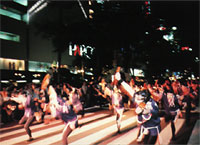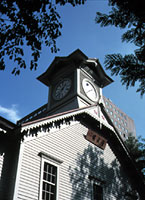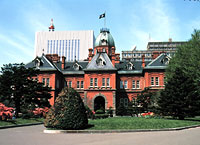|
|
|||||||
|
|
|||||||
|
|||||||
| | Web Japan >>| Trends in Japan >> | Arts & Entertainment >> | Heavenly Hokkaido | |
|
HEAVENLY HOKKAIDO Northern Island Offers Festivals and Great Food (June 2, 2003) For most of Japan, June sees the arrival of the annual rainy season and a spell of miserable weather, but in Hokkaido, which does not have a rainy season, it is the most pleasant time of the year. Hokkaido is located at the far north of the Japanese archipelago and spends some of the year covered in snow. Once the snow melts, the island really heats up with the staging of a huge festival, the Yosakoi Soran Festival, in the capital Sapporo, which this year is taking place from June 4 to 8.
40,000 Join in the Fun Although the Yosakoi Soran Festival is now established alongside the Sapporo Snow Festival as one of the major events in Hokkaido's calendar, it actually has only a short history. This year's event is just the twelfth so far. This relatively new festival is a blend of the Yosakoi Festival held in Kochi in southern Japan and Hokkaido's traditional soran-bushi fishermen's folk songs. The story of the festival began when a student from Sapporo saw the excitement generated by Kochi's Yosakoi Festival and had a dream: "If only we had a festival like that in Hokkaido." Since this dream became reality over a decade ago, the festival has captured the hearts of the people of Hokkaido. The number of participants and spectators has grown with every staging, and the event is now an essential early-summer rite in Sapporo. Snow Festival Attracts 2 Million Visitors The 2003 Snow Festival was the fifty-fourth since the event began, making it relatively young compared with many festivals and ceremonies on Japan's largest island, Honshu. One of the reasons for this is that the Japanese government only really began the work of developing Hokkaido after the establishment of the Hokkaido Colonization Commission in 1869. That year, the island's capital functions were located in Sapporo, and, based on an ambitious urban plan, work was begun on building a city with an orderly street pattern. In contrast with the many seats of local government on Honshu that developed from castle towns, the construction of Sapporo's basic urban infrastructure was influenced by European culture, resulting in a city with an exotic atmosphere unlike anything found in the major cities of Honshu.
A Popular Domestic Destination One of the key figures of Sapporo Agricultural College was Dr. William S. Clark. When the college opened in 1876, Clark, then president of Massachusetts Agricultural College, was invited to become vice-president. He accepted and, using the Bible to teach the students morality, fostered the education of many people who went on to play leading roles in Hokkaido's development. He was only in Japan for eight months, but under his tutelage the college turned out such internationally minded people as Kanzo Uchimura and Inazo Nitobe, who contributed greatly to Meiji era thought. Clark's final words to his students were, "Boys be ambitious," and this phrase is still famous today. In the 130-plus years since the Hokkaido Colonization Commission was established in 1869, Sapporo has been the base of Hokkaido's development and has grown from a town of less than 1,000 people to be the fifth largest city in Japan with a population of 1.84 million. When Japanese salarymen are polled as to where they would most like to be transferred to, Sapporo is always the top choice. Besides its exotic atmosphere and easy access to Hokkaido's stunning natural environment, it also offers a wealth of culinary delights. Hokkaido is a major center of agriculture and livestock farming, not to mention home to a thriving fishing industry. Sapporo's Central Wholesale and Nijo Markets are filled with such an array of seafood, meat products, and seasonal vegetables that just walking around them is a feast of the senses. Hokkaido cuisine tends to be uncomplicated: There is no need for fanciness when the ingredients taste as good as those yielded by the island's rich natural larder. One of the region's signature dishes is ishikari-nabe, a hearty red-miso-flavored hotpot of salmon and other seafood, Japanese radish, leeks, Chinese cabbage, and tofu. This delicious stew is a must for visitors to the region. Perhaps the most famous dish in Hokkaido is Sapporo ramen, miso-flavored noodle soup topped with butter, seaweed, corn, and other treats. Another local favorite is a sizzling barbecue of lamb and vegetables known as Ghengis Khan, and as if that wasn't enough, Sapporo is also famous for its beer. All in all, a trip to Sapporo is a truly mouth-watering prospect! Related Web SitesYosakoi Soran Festival (site is Japanese only) "Sapporo Snow Festival" in Japan Atlas "Yosakoi Festival" in Japan Atlas Sapporo's Central Wholesale ishikari-nabe in Kids Web Japan Copyright (c) 2004 Web Japan. Edited by Japan Echo Inc. based on domestic Japanese news sources. Articles presented here are offered for reference purposes and do not necessarily represent the policy or views of the Japanese Government. |
DANCING IN THE STREETS (August 13, 2003) MIDSUMMER NIGHTS' REVELRY (July 22, 2003) RITES OF SUMMER (June 27, 2003) MONEY MAKEOVER (September 27, 2002) |
|
|





